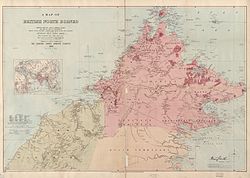British North Borneo
| North Borneo | ||||||||||||||||||
| Borneo Utara | ||||||||||||||||||
| Protectorate of the United Kingdom | ||||||||||||||||||
|
||||||||||||||||||
|
||||||||||||||||||
|
Motto (Latin: Pergo et Perago) "I undertake and I achieve" |
||||||||||||||||||
|
Anthem God Save the King/Queen |
||||||||||||||||||
|
North Borneo border, 1899.
|
||||||||||||||||||
| Capital | Sandakan (pre war); Jesselton (post war) | |||||||||||||||||
| Languages | English, Kadazan Dusun, Bajau, Murut, Sabah Malay, Chinese etc. | |||||||||||||||||
| Government | Protectorate, Crown Colony | |||||||||||||||||
| Governor | ||||||||||||||||||
| • | 1896–1901 | Robert Scott (North Borneo) | ||||||||||||||||
| Historical era | New Imperialism | |||||||||||||||||
| • | North Borneo Company | May 1888 | ||||||||||||||||
| • | Protectorate | 1888 | ||||||||||||||||
| • | Japanese invasion | 1 January 1942 | ||||||||||||||||
| • | Allied liberation | June 1945 | ||||||||||||||||
| • | Colony of North Borneo | 15 July 1946 | ||||||||||||||||
| • | Seven Turtle Islands (including Cagayan de Tawi-Tawi) ceded to the Philippine government | 16 October 1947 | ||||||||||||||||
| • | Malaysia Agreement | 16 September 1963 | ||||||||||||||||
| Area | ||||||||||||||||||
| • | 1936 | 76,115 km² (29,388 sq mi) | ||||||||||||||||
| Population | ||||||||||||||||||
| • | 1936 est. | 285,000 | ||||||||||||||||
| Density | 3.7 /km² (9.7 /sq mi) | |||||||||||||||||
| Currency |
North Borneo dollar, until 1953 Malaya and Borneo dollar, after 1953 |
|||||||||||||||||
|
||||||||||||||||||
| Today part of |
|
|||||||||||||||||
North Borneo also described as the State of North Borneo was a state that existed from 1882 until 1946. The state came about owing to the grant by the Sultans of Brunei and Sulu of large tracts of land in 1877 and 1878 to a syndicate of businessmen who had established a depot at Sandakan Bay. In 1881 the North Borneo Provisional Association was incorporated by Royal Charter in the United Kingdom empowering the Company to administer the country, subject to the reservation of some supervisory power to the Secretary of State and, later in 1881 the North Borneo Chartered Company was formed to take over the administration. The country was placed under British protection in 1888 under an agreement between the Company and the British government concluded on 12 May 1888. From 1942 to 1945, North Borneo was occupied by Japanese military forces, before they were driven out by Australian troops. Further to an agreement between the Company and the Government of the United Kingdom concluded on 26 June 1946, the United Kingdom annexed the State of North Borneo on 15 July 1946 which from that time was to form part of the Colony of North Borneo. In 1947 administration over seven British-administered islands in north-eastern Borneo named Turtle Islands that were already under the sovereignty of the Republic of the Philippines was transferred to the Philippine government together with Cagayan de Tawi-Tawi. This transfer of administration was completed under a past treaty signed between the United Kingdom and the United States. Today, the former North Borneo is part of Malaysia as the state of Sabah.
Before the eastern part of the territory was ceded by the Sultanate of Brunei to the Sultanate of Sulu as a gift for helping the Bruneian forces during a civil war that happened in Brunei, the whole territory was once under the rule of the Bruneian Empire. In 1761, British East India Company officer Alexander Dalrymple concluded an agreement with the Sultan of Sulu to allow him occupation of Balambangan Island, located 51 km off the coast of Kudat and known to the British as Felicia Island. A free port was then established here which was of importance for the interest of Britain in the east Asia region, namely, trade with China. The port however failed to become a long term success due to constant pirate attacks as well as other reasons and the British left in 1805.
...
Wikipedia



